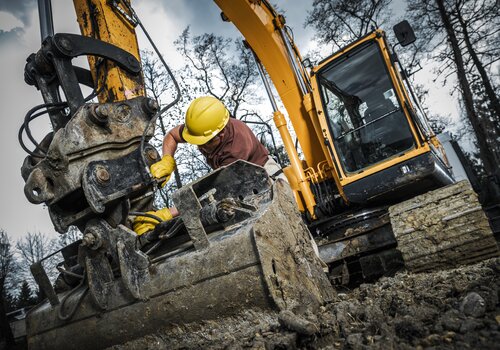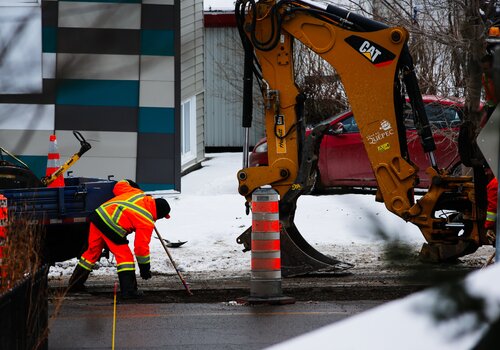You’ve heard it before but let it sink in. More workers die in construction than in any other industry. Bureau of Labor Statistics show that 985 workers lost their lives in construction in 2021. Accidents involving heavy equipment often result in severe injury and death. Earthmoving equipment can cause accidents like workers being pinned between two vehicles, or between a vehicle and a fixed object; site personnel can be struck by swinging attachments or crushed under overturned vehicles. Electrocution can occur when earthmoving or lifting equipment comes into contact with overhead or underground power lines.
Only by understanding how these accidents happen can we address solutions.
Safety Mistake #1: Failure to ensure equipment is safe
A study that looked at the factors contributing to accidents involving heavy equipment found that contributing factors were non-functioning seat belts, malfunctioning backup alarms, and poorly maintained equipment. In addition, many employees are injured or killed when the equipment they are repairing is turned on by a co-worker or when energy is released from the equipment.
Tip: Inspect equipment daily and follow lock-out, tagout procedures
Equipment inspections are not just to keep an eye on worn parts or productivity-related issues. They’re also about safety. Among the equipment components that OSHA says should be checked daily are brakes, couplers, horns, seat belts, mirrors, lights, tires, and steering.
In addition, before any equipment maintenance or repair is performed, lockout/tagout procedures should be followed. OSHA requires that when mobile equipment is being maintained or repaired it should be stopped and the power source deactivated. Label the equipment with tags on the controls as required by OSHA to prevent accidental use of unsafe equipment. The lack of lockout/tagout equipment-specific procedures is one of the most cited OSHA violations.
Safety Mistake #2: Failing to protect workers on foot around heavy equipment
Operators of large heavy equipment simply cannot see people who are on foot in the blind spots of their vehicles. This presents a dangerous situation for people whose work requires they be on the ground near the equipment including surveyors, spotters, and grade checkers.
Tip: Try new technologies to increase visibility on the jobsite
New technologies boost visibility, making it safer for employees to work near heavy equipment. Features like 360-degree cameras and backup alarms on the equipment itself can help prevent accidents. Proximity detection technology sends alerts when an individual or object is within close proximity to another individual or object, which can help forewarn impending danger. A recent example is Leica’s Icon PA-10, which offers greater awareness of the entire jobsite. Personnel on the ground are equipped with an electronic tag that emits lights, vibration, and sound when any equipment is too close to the operator. Similarly, equipment operators can view the location of the worker from the cab.
Safety Mistake: #3: Failure to plan ahead to prevent struck-by incidents
Struck-by accidents are a leading cause of death among construction workers, and since 1992 the leading cause of nonfatal injuries in the construction industry. In a 2022 webinar held during the National Stand-Down to Prevent Struck-By Incidents. The Center for Construction Research and Training (CPWR) highlighted some of the hazards related to struck-by incidents, including couplers that unexpectedly release attachments, as well as accidents when lifting or moving material on the jobsite.
One of the panelists, Mike Walsh, President of Dearborn Engineers & Constructors, contends that every move needs a plan to mitigate struck-by accidents. He also suggests that planning should be executed for all movement both vertical and horizontal, and not only for cranes but for any kind of equipment doing lifting such as excavators, telehandlers, and forklifts.
Tip: Plan ahead of time, and again right before you move equipment or materials
Actively investigate the jobsite well ahead of when the work will be completed, and again immediately before the work. Look for changes in the environment and inspect the equipment and the loads themselves to identify any changes from the plan. Employee training should emphasize keeping out from under-suspended loads and outside the swing radius of backhoes and cranes, lowering the bucket before exiting the cab, and following the manufacturer’s instructions for operating couplers. Employers should use zones and barriers to separate workers from heavy equipment. Access to additional resources can be found at CPWR.
Safety Mistake #4: Failure to adhere to OSHA trenching standards
Excavating contractors need to pay more attention to safety standards for trenches. In 2021, OSHA announced enhanced enforcement initiatives after a rise in trench-related accidents. In one such incident on June 28, 2022, two workers, aged 20 and 39, suffered fatal injuries in Jarrell, Texas, when the unprotected trench more than 20 feet deep collapsed upon them as they worked. Trench shields, which could have saved their lives, sat unused beside the excavation.
Tip: Remember to slope it, shore it, shield it
According to OSHA, trenches five feet deep or greater require a protective system to prevent workers from trench collapse. Trenches 20 feet deep or greater require a protective system designed by a registered professional engineer. Three types of systems will protect workers:
You can Slope It by cutting back the trench wall at an angle inclined away from the excavation. You can Shore It by installing aluminum hydraulics or other types of supports to prevent soil movement. You can Shield It by using trench boxes or other types of supports to prevent soil cave-ins.
Training should remind employees to never enter a trench before it has been fully inspected; protection measures are in place; there is a safe way to enter and exit; and it’s free from standing water. Equipment and materials should be located away from the edge. Access additional resources for trench safety from OSHA.
Equipment-related accidents are among the deadliest in the construction industry. The vast majority of deadly accidents would be preventable if managers and employees follow these simple tips for safer work sites.












